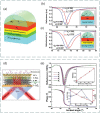2D Material-Based Optical Biosensor: Status and Prospect
- PMID: 34898053
- PMCID: PMC8811838
- DOI: 10.1002/advs.202102924
2D Material-Based Optical Biosensor: Status and Prospect
Abstract
The combination of 2D materials and optical biosensors has become a hot research topic in recent years. Graphene, transition metal dichalcogenides, black phosphorus, MXenes, and other 2D materials (metal oxides and degenerate semiconductors) have unique optical properties and play a unique role in the detection of different biomolecules. Through the modification of 2D materials, optical biosensor has the advantages that traditional sensors (such as electrical sensing) do not have, and the sensitivity and detection limit are greatly improved. Here, optical biosensors based on different 2D materials are reviewed. First, various detection methods of biomolecules, including surface plasmon resonance (SPR), fluorescence resonance energy transfer (FRET), and evanescent wave and properties, preparation and integration strategies of 2D material, are introduced in detail. Second, various biosensors based on 2D materials are summarized. Furthermore, the applications of these optical biosensors in biological imaging, food safety, pollution prevention/control, and biological medicine are discussed. Finally, the future development of optical biosensors is prospected. It is believed that with their in-depth research in the laboratory, optical biosensors will gradually become commercialized and improve people's quality of life in many aspects.
Keywords: 2D materials; evanescent wave; fluorescence resonance energy transfer; optical biosensor; surface plasmon resonance.
© 2021 The Authors. Advanced Science published by Wiley-VCH GmbH.
Conflict of interest statement
The authors declare no conflict of interest.
Figures





























References
-
- Westerveld W. J., Mahmud‐Ul‐Hasan M., Shnaiderman R., Ntziachristos V., Rottenberg X., Severi S., Rochus V., Nat. Photonics 2021, 15, 341.
Publication types
MeSH terms
Substances
Grants and funding
LinkOut - more resources
Full Text Sources
